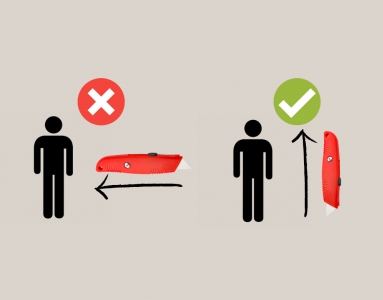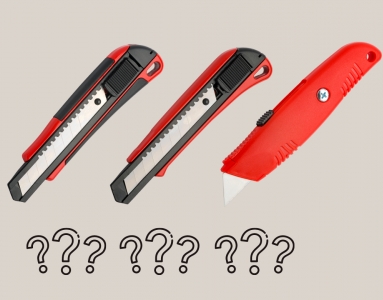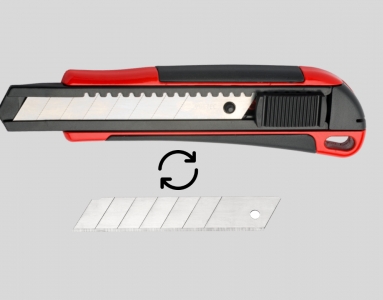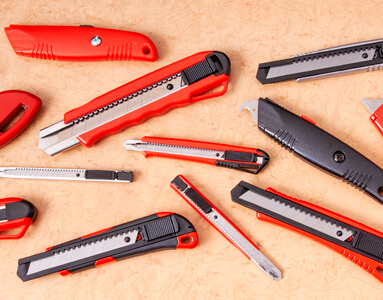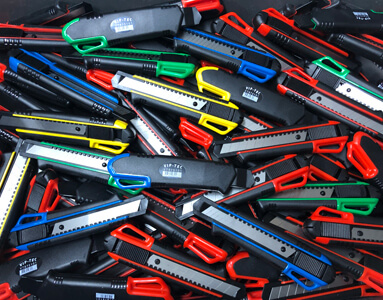10 Important Utility Knife Tips
We use a utility knife for our professional cutting works and do it yourself purposes in order to cut different materials and surfaces. There are some easy to apply but so important points that enable us to use utility knife efficiently and with a higher degree of safety. In this article, we will share 10 important tips that are critical for cutting performance and your safety while you are performing your cutting works.
1) Retract Blade into Handle When The Utility Knife is Not in Use
Please retract the blade which was in open mode while you were performing your cutting works. Utility Knife Blade is sharp enough and that sharp blade may cause an injury when it is the open mode. For that reason, we highly recommend you check your utility knife blade once you finish your cutting work and retract the blade into the utility knife handle when it is not in use. If you want to use a utility knife that has an auto-retracting mechanism you may take VIP-TEC safety utility knife models.
2) Keep Your Body Away From Cutting Line
So many injuries happen when people keep their body and their other hand so close to the cutting line. We highly recommend you to put enough distance between your body and cutting line in order to mitigate all risks that may arise from cut injuries. We also highly recommend you to set the cutting line parallel to your body for your safety.
3) Do Not Talk or Look Away When You Cut Material
It is important to focus on cutting work. It requires all of your attention that is why you should focus on your cutting works and avoid talking and looking away. Thus you can hold control of your cutting work and protect yourself from any accidents.
4) Cut Your Materials on Stable Surface
Please pay attention to placing your cutting materials on a stable surface. Thus you could prevent yourself from any cut caused by any tilting or tipping of the materials. Cutting works that are performed on a stable surface will be much better for your safety and cutting performance of the utility knife.
5)Use a Glove
It is highly important to wear a cut-resistant glove in order to protect your hands from any cut or nick. Cutting works which are performed by wearing glove will protect your hands in case of an accident. Like other precautions, wearing a glove will also give you a safer cutting experience.
6) Check Condition of Utility Knife Blade Regularly
As you cut materials with your utility knife, its blade edge becomes dull and rusted. Cutting with a dull and rusted blade edge requires much more force to be applied and it will make you exhausted. Applying too much force may also lead to some safety problems such as slippage of utility knife or damage on cutting material. For this reason, it is better to check the condition of the utility knife blade regularly and snap off its edge or replace it with the new one. Please click the link if you want to see how to snap off a utility knife blade and how to replace a utility knife blade.
7) Do Not Use Utility Knife for The Improper Purpose
Using your utility knife for improper purposes may lead to unwanted accidents. For that reason, we don’t recommend using a utility knife as a scraper, screwdriver, chisel, or kitchen knife.
8)Use Plier, Glove, and Goggles When Snap-Off Utility Knife Blade.
Although the utility knife is used for different cutting works many people don’t know how to snap off the utility knife blade or try to break it in unsafe ways. We highly recommend you to use a plier for a safe break before you break off the utility knife blade. Thus you can grasp the knife more tightly and snap off the blade with less amount of force. In addition to plier, wearing gloves and goggles also enable us to perform cutting works with a higher degree of safety.
9)Dispose of Dull Blade and Broken Blade Edge in Puncture-Resistant Container.
As we all know that utility knife blade is sharp and it may cause injuries if we don’t store them carefully. In order not to cause any injury or accident, dull blades and broken blade edges must be disposed of in a puncture-resistant container.
10) Make Sure You Use Right Utility Knife for Your Cutting Works
Some cutting works require heavy-duty utility knife while the others require normal duty utility knife or precision utility knives. Be sure that you use a proper utility knife for your cutting work. If you want to know which utility knife is the best for your cutting work please contact us.


